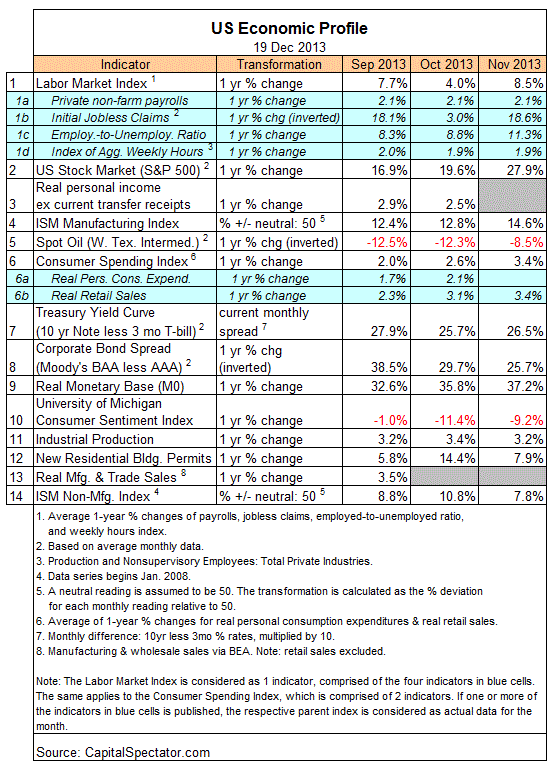‘Tis the season for predictions and all the usual caveats apply. But amid the din of forecasts as the year winds down is one outlook that’s worth a closer a look for what it says about the UK, the Eurozone, and the price tag for embracing a deeply flawed monetary policy inside a misguided currency union.
“The UK is forecast to be the second most successful of the Western economies after the US,” advises the Centre for Economics and Business Research (CEBR) in a new report published today. “Positive demographics with continuing immigration, rather less exposure to the problems of the Eurozone than other European economies combine with relatively low taxes by European standards to encourage faster growth than in most Western economies.” As it travels along the road to recovery, Britain will edge out France to become the fifth-largest economy on the planet in five years, pushing aside Germany to become Europe’s leading economy by 2030, CEBR projects. It seems that the sun is no longer setting on the British Empire in macro terms.
A lot can change between now and five years, to say nothing of what will unfold over the next three decades. But CEBR’s forecast certainly sounds plausible based on what we know about Britain’s economy this year. If you’ve been following the macro news for the UK, you know that it’s been posting encouraging numbers for months. There’s a fierce debate about why Britain’s economy is recovering. There’s also plenty of skepticism about whether the rebound is sustainable or even healthy—some analysts say that it’s overly reliant on a housing boom, for instance.
But there’s no denying that the UK’s generating numbers that stand in sharp relief with the Eurozone—particularly for the Eurozone ex-Germany. If you consider the upbeat economic numbers of late for the US and Japan, Europe’s troubles stand out even more. What explains the difference? Surely monetary policy is a big part of the answer, as Ambrose Evans-Pritchard of The Telegraph explains:
The crippled eurozone alone has chosen to stagger on defiantly without monetary crutches. The result has been a double-dip recession of nine quarters, the longest since the Second World War. The austerity regime has been self-defeating even on its own crude terms. Debt ratios have ratcheted up even faster.
It doesn’t help that the euro has been imposed in a region that falls short of Robert Mundell’s standards for defining an optimal currency area. But the euro isn’t going away, at least not for the immediate future. So, what could change? Perhaps the European Central Bank will embrace monetary stimulus in a more aggressive form in 2014, although it’s clear that policy choices to date have been far too modest to make a dent in the lingering troubles that continue to afflict France, Italy and Spain.
In absolute terms, Britain’s ascendancy of late can be attributed to internal economic momentum, supported by the simple fact that the UK still has its own currency and therefore has dodged the macro headwinds that weigh on countries tethered to the euro. In relative terms vis-à-vis the Eurozone, however, Britain’s strength speaks volumes about the self-inflicted problems on the Continent.
“The UK’s rebound is not because fiscal cuts have been milder than in Europe,” observes Evans-Pritchard. “The squeeze has been roughly comparable over the past three years. The difference is monetary policy. Kudos to the Bank of England, rising to a historic challenge once again.”










